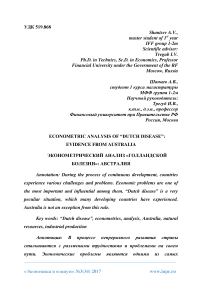Эконометрический анализ «голландской болезни»: Австралия
Автор: Шанцев А.В., Трегуб И.В.
Журнал: Экономика и социум @ekonomika-socium
Рубрика: Основной раздел
Статья в выпуске: 3 (34), 2017 года.
Бесплатный доступ
В процессе непрерывного развития страны сталкиваются с различными трудностями и проблемами на своем пути. Экономические проблемы являются одними из самых влиятельных среди них. С «Голландской болезнью» сталкивались многие развивающиеся страны. Австралия не исключение из этого правила.
"голландская болезнь", эконометрика, анализ, австралия, полезные ископаемые, промышленное производство
Короткий адрес: https://sciup.org/140122974
IDR: 140122974
Текст научной статьи Эконометрический анализ «голландской болезни»: Австралия
"Dutch disease" - the negative effect exerted by the strengthening of the real exchange rate of national currency on economic development as a result of the boom in the mining sector[1]. The boom can be caused by the discovery of mineral deposits or increase in prices of the export of extractive industries. This effect got its name after the discovery of the Netherlands` natural gas fields in 1959. The growth of export of gas has led to an increase in inflation and unemployment, a drop in manufacturing exports and income growth in the 70-ies. Rising oil prices in the mid-70s and early 80s. It caused a similar effect in Saudi Arabia, Nigeria and Mexico. Australia also suffered from “Dutch disease” – first the Australian gold rush in the 19th century, then the mining boom of 2000`s – 2010`s[2]. In this article I will try to check the presence of “Dutch disease” in today`s Australia.
The main indicator for any economy is the level of GDP, thus it was taken as a main variable for the model. It was linked to the level of industrial production, level of Broad money in the economy (M3), exchange rate (AUD to USD), oil price, the difference between import and export, consumer price index (inflation level), unemployment, government revenue and export of raw materials. All of these variables seemed to me as vital indicators for “Dutch disease” analysis, as they show financial and economic health of the country, as well as possible impact of raw material prices on budget revenue and consumers.
Unfortunately, consumer price index (inflation level), unemployment, government revenue and export of raw materials had to be excluded from the final model, as they appeared to be mathematically insignificant. The resulting model can be seen below.
System: AUSTRALIA
Estimation Method: Two-Stage Least Squares
Date: 02/15/17 Time: 20:21
Sample: 1980 2015
Included observations: 36
Total system (balanced) observations 72
Coefficient Std. Error t-Statistic Prob.
|
C(1) |
110.3900 |
104.8848 |
1.052489 |
0.2965 |
|
C(2) |
9.551756 |
2.399658 |
3.980465 |
0.0002 |
|
C(3) |
5.926488 |
1.085710 |
5.458627 |
0.0000 |
|
C(4) |
-417.2349 |
71.53620 |
-5.832500 |
0.0000 |
|
C(7) |
-8.506225 |
2.425356 |
-3.507207 |
0.0008 |
|
C(8) |
0.118032 |
0.008759 |
13.47493 |
0.0000 |
|
C(9) |
-0.368069 |
0.117268 |
-3.138691 |
0.0026 |
|
C(10) |
-0.000311 |
0.000169 |
-1.845170 |
0.0696 |
Determinant residual covariance 213365.9
Equation: GDP = C(1) + C(2)*IND + C(3)*M3 + C(4)*E
Instruments: OIL_PRICE SALDO IND M3 OIL_PRODUCTION GOVREV
UNEMP E C EXP_RM
Observations: 36
|
R-squared Adjusted R-squared S.E. of regression Durbin-Watson stat |
0.975303 Mean dependent var 584.9623 0.972988 S.D. dependent var 441.9583 72.63747 Sum squared resid 168838.5 0.668036 |
Equation: M3 = C(7) + C(8)*GDP + C(9)*OIL_PRICE + C(10)*SALDO
Instruments: OIL_PRICE SALDO IND M3 OIL_PRODUCTION GOVREV
UNEMP E C EXP_RM
Observations: 36
|
R-squared |
0.963825 |
Mean dependent var |
45.38043 |
|
Adjusted R-squared |
0.960433 |
S.D. dependent var |
41.51878 |
|
S.E. of regression |
8.258677 |
Sum squared resid |
2182.583 |
|
Durbin-Watson stat |
0.777664 |
Table 1. Eviews system estimation, 2017
GDP – bln. USD, industrial production (IND) – index points (2010 – 100), M3 – bln. USD, exchange rate (E) – AUD to USD ratio, oil price – USD, import/export balance (SALDO) – bln. USD.
It can be seen from the table that the trustworthiness of the modes is high, as R2 is greater than 95%. All other tests have been passed except for the Durbin-Watson test. The Durbin-Watson test is a statistical test used to test the first-order autocorrelation of the test sequence elements. It is most often used in the analysis of time series of residues and regression models. In my case the variables in both equations are auto-correlated. Besides, the level of statistical errors is quite high in the main equation.
The derived model suggests that there is negative correlation between GDP and exchange rate, meaning that if Australian dollar depreciates – GDP level falls. This in term means that import has more impact on the economy than export, suggesting that “Dutch disease” is not confirmed.
To sum everything up, it would be fair to assume that the derived model did not work properly, showing the absence of “Dutch disease” in Australia, despite its actual presence and evident effect. The level of statistical error in the first equation and auto-correlation of variables prove this. It is difficult to identify the existence of “Dutch disease” in a given country alone, but deriving the right method and gathering adequate data make the task twice as hard. It seems to me that increasing the number of used variables and taking a greater time span for analysis would increase the truthfulness of the model.
«Экономика и социум» №3(34) 2017
URL:
«Экономика и социум» №3(34) 2017
Список литературы Эконометрический анализ «голландской болезни»: Австралия
- Dutch disease. URL:www.thefreedictionary.com/Dutch+disease
- W. Max Corden. Dutch Disease In Australia: Policy Options For A Three Speed Economy 04.2012, URL:http://www.maxcorden.com/wp-content/uploads/2013/12/Dutch-Disease-in-Australia.-Policy-Options-for-a-Three-Speed-Economy-2012.pdf
- Davis G.A., Tilton J.E. The resource curse, 2005 URL:http://lawweb.colorado.edu/profiles/syllabi/banks/Davis%2520%2520Tilton%2520-%2520The%2520resource%2520curse.pdf
- Davis G.A. Extractive Economies, Growth, and the Poor 2009 URL:http://www.google.ru/url?sa=t&rct=j&q=&esrc=s&source=web&cd=10&ved=0ahUKEwj4h6_NgLXSAhVhYZoKHfMiBmYQFghYMAk&url=http%3A%2F%2Fwww.springer.com%2Fcda%2Fcontent%2Fdocument%2Fcda_downloaddocument%2F9783642011023-c1.pdf%3FSGWID%3D0-0-45-802605-p173897422&usg=AFQjCNHmQiUdugigwXv1XT76U41Cexmn1A&cad=rjt
- Трегуб А.В., Трегуб И.В. Методика прогнозирования показателей стохастических экономических систем//Вестник Московского государственного университета леса -Лесной вестник. -2008. -№2 (59). -С. 144-152.
- Трегуб И.В., Хацуков К.Л. Проверка применимости модели для прогнозирования экономических показателей//Экономика и социум. 2014. № 4-4 (13). С. 1345-1349.


